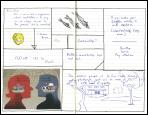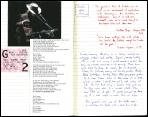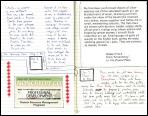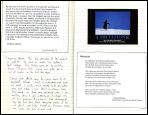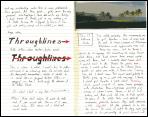Sally
Rooney has a large
number of readers who enjoy and admire her work and an equally large (or
perhaps larger) number of readers who dismiss her out of hand as a niche writer
catering to GenXrs ("the Salinger of the Snapchat generation") by
mirroring their romantic preoccupations. In his NY
Times review of her latest novel, Intermezzo,
Dwight Garner leads with an acknowledgment of the "Rooney backlash"
before mounting a strong defense of the book. And so I find myself in the
unusual position of siding with Dwight Garner, no stranger to snarky
dismissiveness himself, in his assessment. Because Intermezzo, in my opinion, isn't just a good book, it's a terrific
book, in pretty much every respect. It centers largely on five characters. Ivan
is a 22-year-old chess prodigy. His brother Peter, ten years older, is a successful
lawyer. They are both in mourning for the recent death of their father, and,
from early on in the novel, they are both involved in complicated but utterly
convincing relationships. Ivan falls deeply for Margaret, a woman in her
mid-thirties. Peter has a close relationship with Sylvia, an ex-lover his own age with whom he still keeps in
touch, but he is also involved with Naomi, a younger woman
who seems to be using him for her own purposes at the same that he uses her for
his. In the process they manage, without necessarily intending to do so, to create something that feels very much—first to the reader, and then to the characters themselves—like
love. Peter and Ivan have a different kind of complicated (and
convincing) relationship, elements of fondness and love warring against
elements of resentment and dismissiveness as they try to find their way toward one another.
A summary
of this kind perhaps makes it all sound like some kind of hipster soap opera.
What saves it from being so is Rooney's uncanny ability to render the events of
the story from inside the heads of each of her characters. I don't recall
having read a book which so strongly conveys what it's like to be torn in three directions at once as one attempts to
decide what to do in a particular situation. Here's an example in which Margaret, who has just met Ivan at a chess match at a venue where she was the hostess, offers to give him a ride back to his room. They are both aware that there is something in the air between
them, but neither of them is possessed of the sophisticated social skills that
more experienced (and perhaps more jaded) proto-lovers would use to gloss over
the awkwardness. The paragraph serves the very straightforward narrative
purpose of getting Ivan from point A to point B. But Rooney follows Margaret's thoughts very carefully as Margaret considers not only her own feelings in the moment, but
Ivan's as well:
Outside, the car park is glowing
with the skeletal orange light of the streetlamps, the paved surfaces dappled
and glistening. She turns on her wipers and they click and scrape rhythmically
over the windscreen. It happens all the time that she drives someone home like
this, or drops them to the station, and they sit in the car together this way,
chatting about something. It’s just work. And if Ivan doesn’t want to chat, if
he wants to sit there looking at his hands and then looking at her and back at
his hands again, that’s okay — he’s only twenty-two, and very gifted at one
particular kind of board game, and after all there’s no formal etiquette for
the situation. Finding yourself in the car of an older woman after a presumably
strenuous public event, being driven to your accommodation with your little
black suitcase, no one ever teaches you how to behave under such circumstances.
If he wants to sit in silence, looking at his bitten fingernails, that’s
alright, no problem. She, too, of course, is sitting in silence, and has
nothing to say. They come off the main road and down onto the small lane to the
holiday cottages, the gravel crunching noisily under the tyres of Margaret’s
car. She has done nothing wrong, has done nothing at all, in fact, beyond what
is required for the purpose of driving Ivan from the bar to the holiday
village. If she made a little error in the conversation earlier, if she used
one little dubious word or phrase, asking him what he was passionate about,
that was excusable, even in a sense deniable, because subjective. She pulls up
outside one of the houses, a white bungalow with peeling paint and darkened
windows.
Later, as another example, we are inside Peter's head as he
is driving to court and adjusting to the pharmaceuticals he has ingested. I
love the way the scattershot syntax and time dislocations convey what he has
done, what he is doing, what he is seeing, what he is thinking, and how it all
plays out:
In the morning, hiss of the iron,
buttered bread roll, milligram of alprazolam, blue tie or green. Stands at the
dining table rearranging his papers while the coffee cools, thoughts running
rapid with broken phrases, details of argument, streams diverging and
recrossing, hands clammy touching the pages. The point of law. To raise the
question of. His briefcase then, bitter aftertaste, overcoat, and outside the
chill wind of October moves through the leaves of trees. Wide grey streets
around the Green, buses slowing to a stop, wheel and cry of gulls overhead.
Leaves rustle over the park gates. Barred windows of Ship Street then and the
vans reversing. Blue clearing in the white clouds, rain-washed cobbles. River
dissected by the glitter of sunlight, Grattan Bridge. Copper stepped saucer
dome over Portland stone balustraded parapet, dirty green cap in daylight, the
Four Courts. Feels the effects by the time he’s inside, dressing: slow serene
feeling beginning in the hands and feet. Breathing settles. Thoughts grow
orderly and sequential, facts arranged in place, stately procession of claims
and counter-claims. That’s not actually recreational, Naomi told him once.
Like, you can get a prescription if that’s what you’re using it for. Along the
corridor, scent of cleaning fluid, overheard voices. Even medicated he feels
it: the white light of his own righteousness. Clear luminous certainty. In the
courtroom, flow of speech unhurried, precise, inexorable. Admitting no
contradiction. Familiar command almost perfect, yes, and pleasurable even, and
then over.
Yes, this is writing that places demands on you as a
reader. But it offers extraordinary rewards as well. I felt, and feel, like I
got to know these characters as well as I have ever gotten to know most any of
the flesh-and-blood humans beings I have met in my life. And that's because when
you are with an actual person, you can never know for sure what they are really thinking.
But with Rooney, due to her extraordinary psychological insight and writerly control,
you can.
The complexities in a story like this inevitably make you wonder whether the plot will be plausibly satisfyingly resolved, and whether or not the trip will have been worth it. The answer to both questions is a resounding "Yes!" Rooney is no longer occupying the wing in my personal house of literature associated with interesting contemporary writers. She's in the larger room at the back having tea with Jane Austen and George Eliot.


